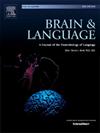Spatiotemporal dynamics of abstract concept processing: An MEG study
IF 2.3
2区 心理学
Q1 AUDIOLOGY & SPEECH-LANGUAGE PATHOLOGY
引用次数: 0
Abstract
Our current understanding of how linguistic concepts are represented and retrieved in the brain is largely based on studies using concrete language, and only few studies have focused on the neural correlates of abstract concepts. The role of the motor system, besides the classical language network, has been intensively discussed in action-related concrete concepts. To advance our understanding of spatiotemporal dynamics underlying abstract concept processing, our study investigated to what extent language and motor regions are engaged in the processing of abstract concepts vs. concrete concepts. We used concrete, metaphorical, and abstract phrases as stimuli, creating a graded continuum of abstractness. Neuromagnetic signals were recorded from 26 Chinese native speakers using a 306-channel whole-head magnetoencephalography (MEG) system. Cluster-based permutation F-tests were carried out on the amplitude of source waveform for individual language and motor regions of interest (ROIs) in the three consecutive time-windows (200–300, 300–400, and 400–500 ms). Results showed that, compared with concrete and metaphorical phrases, abstract phrases evoked significantly weaker activation in the left posterior part of superior temporal sulcus (STS) at 200–300 ms, and significantly stronger activation in the left anterior temporal pole (TP) at 300–400 ms. We found no significant differences in the involvement of motor ROIs across conditions. Our results suggest that concrete concept processing engages more the posterior STS in an earlier time window, while abstract concept processing relies more strongly on the anterior TP in a later time window. Results are discussed by revisiting the ATL (anterior temporal lobe)-hub hypothesis and the novel definition of concrete and abstract concepts.
抽象概念加工的时空动态:脑磁图研究。
我们目前对语言概念如何在大脑中表征和检索的理解主要基于使用具体语言的研究,只有少数研究关注抽象概念的神经关联。除了经典的语言网络外,运动系统的作用也在与动作相关的具体概念中得到了深入的讨论。为了进一步了解抽象概念加工背后的时空动态,本研究调查了语言和运动区域在抽象概念和具体概念加工中的参与程度。我们使用具体的、隐喻的和抽象的短语作为刺激,创造了抽象性的分级连续体。采用306通道全头脑磁图(MEG)系统记录26例汉语母语者的神经磁信号。在连续的三个时间窗(200- 300ms、300- 400ms和400- 500ms)中,对单个语言和运动感兴趣区域(roi)的源波形幅度进行了基于聚类的排列f检验。结果表明,相对于具体短语和隐喻短语,抽象短语在200-300 ms时诱发的左侧颞上沟后部(STS)激活显著减弱,而在300-400 ms时诱发的左侧颞前极(TP)激活显著增强。我们发现不同条件下运动roi的参与没有显著差异。我们的研究结果表明,在较早的时间窗口中,具体概念加工更多地依赖于后路STS,而在较晚的时间窗口中,抽象概念加工更多地依赖于前路TP。通过重新审视ATL(前颞叶)-中枢假说和具体和抽象概念的新定义来讨论结果。
本文章由计算机程序翻译,如有差异,请以英文原文为准。
求助全文
约1分钟内获得全文
求助全文
来源期刊

Brain and Language
医学-神经科学
CiteScore
4.50
自引率
8.00%
发文量
82
审稿时长
20.5 weeks
期刊介绍:
An interdisciplinary journal, Brain and Language publishes articles that elucidate the complex relationships among language, brain, and behavior. The journal covers the large variety of modern techniques in cognitive neuroscience, including functional and structural brain imaging, electrophysiology, cellular and molecular neurobiology, genetics, lesion-based approaches, and computational modeling. All articles must relate to human language and be relevant to the understanding of its neurobiological and neurocognitive bases. Published articles in the journal are expected to have significant theoretical novelty and/or practical implications, and use perspectives and methods from psychology, linguistics, and neuroscience along with brain data and brain measures.
 求助内容:
求助内容: 应助结果提醒方式:
应助结果提醒方式:


